Stand Delineation of Pinus sylvestris L. Plantations Suffering Decline Processes Based on Biophysical Tree Crown Variables: A Necessary Tool for Adaptive Silviculture
Abstract
1. Introduction
2. Materials and Methods
2.1. Study Area
2.2. Field Data
2.3. Remote Sensing Data
2.3.1. Airborne Laser Scanning Data
2.3.2. WorldView-2 Images
2.4. Methods
2.4.1. Segmentation for Tree Crown Delineation
2.4.2. LAI and Pigments Data Modeling
2.4.3. Stand Delineation
2.4.4. Stand Cartography
3. Results
3.1. Tree Crown Biochemical Variables of Different Defoliation Levels
3.2. Individual Tree Crown Delineation Performance
3.3. Models for Defoliation, LAI, and Needle Biochemical Parameter Estimations
3.4. Stand Delineation and Stand Maps Based on Biophysical Variables
4. Discussion
4.1. Tree Crown Biochemical Variables at the Plot Level
4.2. Individual Tree Crown Delineation Performance
4.3. LAI and Pigments Modeling
4.4. Stand Delineation Based on Biophysical Variables
4.5. Distribution Maps of Stands Based on Severity Classes
4.6. Adaptive Silvicultural Applications of Tree Health Workflow
5. Conclusions
Supplementary Materials
Author Contributions
Funding
Institutional Review Board Statement
Informed Consent Statement
Data Availability Statement
Acknowledgments
Conflicts of Interest
References
- Caudullo, G.; Barredo, J.I. A georeferenced dataset of drought and heat-induced tree mortality in Europe. One Ecosyst. 2019, 4. [Google Scholar] [CrossRef]
- Carnicer, J.; Coll, M.; Ninyerola, M.; Pons, X.; Sánchez, G.; Peñuelas, J. Widespread crown condition decline, food web disruption, and amplified tree mortality with increased climate change-type drought. Proc. Natl. Acad. Sci. USA 2011, 108, 1474–1478. [Google Scholar] [CrossRef]
- Trumbore, S.; Brando, P.; Hartmann, H. Forest health and global change. Science 2015, 349, 814–818. [Google Scholar] [CrossRef]
- Gustafson, E.J.; Sturtevant, B.R. Modeling forest mortality caused by drought stress: Implications for climate change. Ecosystems 2013, 16, 60–74. [Google Scholar] [CrossRef]
- Flannigan, M.D.; Amiro, B.D.; Logan, K.A.; Stocks, B.J.; Wotton, B.M. Forest fires and climate change in the 21st century. Mitig. Adapt. Strateg. Glob. Chang. 2006, 11, 847–859. [Google Scholar] [CrossRef]
- Nagel, T.A.; Firm, D.; Mihelic, T.; Hladnik, D.; Groot, M.; Rozenbergar, D. Evaluating the influence of integrative forest management on old-growth habitat structures in a temperate forest region. Biol. Conserv. 2017, 216, 101–107. [Google Scholar] [CrossRef]
- Gaztelurrutia, R.M.; Oviedo, J.A.B.; Pretzsch, H.; Löf, M.; Peinado, R.R. A review of thinning effects on Scots pine stands: From growth and yield to new challenges under global change. For. Syst. 2017, 26, 9. [Google Scholar]
- Camarero, J.J.; Linares, J.C.; Barreda, S.G.; Salguero, S.R.; Gazol, A.; Cerrillo, N.R.M.; Carreira, J. The multiple causes of forest decline in Spain: Drought, historical logging, competition and biotic stressors. In Dendroecology; Springer: Cham, Switzerland, 2017; pp. 307–323. [Google Scholar]
- Toro, T.J.; Cerrillo, N.R.M. Analysis of Site-dependent Pinus halepensis Mill. Defoliation Caused by ‘Candidatus Phytoplasma pini’ through Shape Selection in Landsat Time Series. Remote Sens. 2019, 11, 1868. [Google Scholar] [CrossRef]
- Bussotti, F.; Pollastrini, M. Observing climate change impacts on European forests: What work sand what does not in ongoing long-term monitoring networks. Front. Plant Sci. 2017, 8, 629. [Google Scholar] [CrossRef]
- Adams, H.D.; Zeppel, M.J.; Anderegg, W.R.; Hartmann, H.; Landhäusser, S.M.; Tissue, D.T.; Anderegg, L.D. A multi-species synthesis of physiological mechanism in drought-induced tree mortality. Nat. Ecol. Evol. 2017, 1, 1285–1291. [Google Scholar] [CrossRef]
- Laughlin, J.; Cook, P. Inventory-based forest health indicators: Implications for national forest management. J. For. 2003, 101, 11–17. [Google Scholar]
- Dobbertin, M.; Hug, C.; Mizoue, N. Using slides to test for changes in crown defoliation assessment methods. Part I: Visual assessment of slides. Environ. Monit. Assess. 2004, 98, 295–306. [Google Scholar] [CrossRef] [PubMed]
- Cerrillo, N.R.M.; Martínez, V.M.Á.; Acosta, C.; Rodriguez, G.P.; Cuesta, S.R.; Gomez, R.F. Integration of WorldView-2 and airborne laser scanning data to classify defoliation levels in Quercus ilex L. Dehesas affected by root rot mortality: Management implications. For. Ecol. Manag. 2019, 451. [Google Scholar] [CrossRef]
- Huang, C.Y.; Anderegg, W.R.; Asner, G.P. Remote sensing of forest die-off in the Anthropocene: From plant ecophysiology to canopy structure. Remote Sens. Environ. 2019, 231. [Google Scholar] [CrossRef]
- Wulder, M.A.; Dymond, C.C.; White, J.C.; Leckie, D.G.; Carroll, A.L. Surveying mountain pine beetle damage of forests: A review of remote sensing opportunities. For. Ecol. Manag. 2006, 221, 27–41. [Google Scholar] [CrossRef]
- Stone, C.; Mohammed, C. Application of remote sensing technologies for assessing planted forests damaged by insect pests and fungal pathogens: A review. Curr. For. Rep. 2017, 3, 75–92. [Google Scholar] [CrossRef]
- Lausch, A.; Erasmi, S.; King, D.; Magdon, P.; Heurich, M. Understanding forest health with remote sensing-part II—A review of approaches and data models. Remote Sens. 2017, 9, 129. [Google Scholar] [CrossRef]
- Sapkota, B.; Liang, L. A multistep approach to classify full canopy and leafles strees in bottom land hard woods using very high-resolution imagery. J. Sustain. Forest. 2018, 37, 339–356. [Google Scholar] [CrossRef]
- Solberg, S.; Næsset, E.; Hanssen, K.; Christiansen, E. Mapping defoliation during a severe insect attack on Scots pine using airborne laser scanning. Remote Sens. Environ. 2006, 102, 364–376. [Google Scholar] [CrossRef]
- Meng, R.; Dennison, P.; Zhao, F.; Shendryk, I.; Rickert, A.; Hanavan, R.; Cook, B.; Serbin, S. Mapping canopy defoliation by herbivorous insects at the individual tree level using bi-temporal airborne imaging spectroscopy and LiDAR measurements. Remote Sens. Environ. 2018, 215, 170–183. [Google Scholar] [CrossRef]
- Eysn, L.; Hollaus, M.; Schadauer, K.; Pfeifer, N. Forest delineation based on airborne LIDAR data. Remote Sens. 2012, 4, 762–783. [Google Scholar] [CrossRef]
- Martínez, V.M.Á.; Cerrillo, N.R.M.; Clemente, H.R.; Lazo, D.J. Semi-automated stand delineation in Mediterranean Pinus sylvestris plantations through segmentation of LiDAR data: The influence of pulse density. Int. J. Appl. Earth Obs. 2017, 56, 54–64. [Google Scholar] [CrossRef]
- Anderegg, W.; Hicke, J.; Fisher, R.; Allen, C.; Aukema, J.; Bentz, B.; Pan, Y. Tree mortality from drought, insects, and their interactions in a changing climate. New Phytol. 2015, 208, 674–683. [Google Scholar] [CrossRef] [PubMed]
- Belgiu, M.; Drăguţ, L. Random forest in remote sensing: A review of applications and future directions. ISPRS J. Photogramm. Remote Sens. 2016, 114, 24–31. [Google Scholar] [CrossRef]
- Valbuena, R.; Eerikäinen, K.; Packalen, P.; Maltamo, M. Gini coefficient predictions from airborne lidar remote sensing display the effect of management intensity on forest structure. Ecol. Indic. 2016, 60, 574–585. [Google Scholar] [CrossRef]
- Marx, A.; Kleinschmit, B. Sensitivity analysis of RapidEye spectral bands and derived vegetation indices for insect defoliation detection in purê Scots pine stands. iForest 2017, 10, 659–668. [Google Scholar] [CrossRef]
- Antonarakis, A.S.; Munger, J.W.; Moorcroft, P.R. Imaging spectroscopy-and lidar-derived estimates of canopy composition and structure to improve predictions of forest carbon fluxes and ecosystem dynamics. Geophys. Res. Lett. 2014, 41, 2535–2542. [Google Scholar] [CrossRef]
- Beland, M.; Parker, G.; Sparrow, B.; Harding, D.; Chasmer, L.; Phinn, S.; Strahler, A. On promoting the use of lidar systems in forest ecosystem research. For. Ecol. Manag. 2019, 450. [Google Scholar] [CrossRef]
- Eichhorn, J.; Roskams, P.; Ferretti, M.; Mues, V.; Szepesi, A.; Durrant, D. Visual Assessment of crown condition and damaging agents. Manual Part IV. In Manual on Methods and Criteria for Harmonized Sampling, Assessment, Monitoring and Analysis of the Effects of Air Pollution on Forests; UNECE ICP Forests Programme Co-Ordinating Centre: Hamburg, Germany, 2010. [Google Scholar]
- Ferretti, M.; König, N.; Granke, O. Quality Assurance within the ICP-Forests monitoring programme. Manual Part III. In Manual on Methods and Criteria for Harmonized Sampling, Assessment, Monitoring and Analysis of the Effects of Air Pollution on Forests; UNECE ICP Forests Programme Co-Ordinating Centre: Hamburg, Germany, 2010; ISBN 978-3-926301-03-1. [Google Scholar]
- Cerrillo, N.R.M.; Trujillo, J.; Orden, M.; Clemente, H.R. Hyperspectral and multispectral satellite sensors for mapping chlorophyll content in a Mediterranean Pinus sylvestris L. plantation. Int. J. Appl. Earth Obs. 2014, 26, 88–96. [Google Scholar] [CrossRef]
- Abadia, J.; Abadia, J. Iron and Plant Pigments; Academic Press: Cambridge, MA, USA, 1993. [Google Scholar]
- Clemente, H.R.; Cerrillo, N.R.M.; Tejada, Z.P.J. Carotenoid content estimation in a heterogeneous conifer forest using narrow-band índices and PROSPECT+ DART simulations. Remote Sens. Environ. 2012, 127, 298–315. [Google Scholar] [CrossRef]
- Dufrêne, E.; Bréda, N. Estimation of deciduous forest leaf area index using direct and indirect methods. Oecologia 1995, 104, 156–162. [Google Scholar] [CrossRef] [PubMed]
- Sokal, R.; Rohlf, F.J. Biometry: The Principles and Practice of Statistics in Biological Research, 3rd ed.; W. H. Freeman: New York, NY, USA, 1995. [Google Scholar]
- R Development Core Team. R: A Language and Environment for Statistical Computing; R Foundation for Statistical Computing: Vienna, Austria, 2018. [Google Scholar]
- Nouri, H.; Beecham, S.; Anderson, S.; Nagler, P. High spatial resolution WorldView-2 imagery for mapping NDVI and its relationship to temporal urban landscape evapotranspiration factors. Remote Sens. 2014, 6, 580–602. [Google Scholar] [CrossRef]
- Khosravipour, A.; Skidmore, A.; Isenburg, M.; Wang, T.; Hussin, Y. Generating pit-free canopy height models from airborne lidar. Photogramm. Eng. Remote Sens. 2014, 80, 863–872. [Google Scholar] [CrossRef]
- Isenburg, M. LAStools–Efficient LiDAR Processing Software (Version 1.8, Licensed). Available online: http://rapidlasso.com/LAStools (accessed on 17 October 2018).
- Conrad, O.; Bechtel, B.; Bock, M.; Dietrich, H.; Fischer, E.; Gerlitz, L.; Böhner, J. System for automated geoscientific analyses (SAGA) v. 2.1.4. Geosci. Model Dev. Dis. 2015, 8, 2271–2312. [Google Scholar]
- QGIS Development Team. Geographic Information System; Open Source Geospatial Found: Chicago, IL, USA, 2018. [Google Scholar]
- Li, W.; Guo, Q.; Jakubowski, M.K.; Kelly, M. A new method for segmenting individual trees from the lidar point cloud. Photogramm. Eng. Rem. S. 2012, 78, 75–84. [Google Scholar] [CrossRef]
- Waser, L.T.; Küchler, M.; Jütte, K.; Stampfer, T. Evaluating the potential of WorldView-2 data to classify tree species and different levels of ash mortality. Remote Sens. 2014, 6, 4515–4545. [Google Scholar] [CrossRef]
- Oumar, Z.; Mutanga, O. Integrating environmental variables and WorldView-2 image data to improve the prediction and mapping of Thaumastocoris peregrinus (bronze bug) damage in plantation forests. ISPRS J. Photogramm. Remote Sens. 2014, 87, 39–46. [Google Scholar] [CrossRef]
- Kantola, T.; Vastaranta, M.; Yu, X.; Saarenmaa, L.P.; Holopainen, M.; Talvitie, M.; Hyyppa, J. Classification of defoliated trees using tree-level airborne laser scanning data combined with aerial images. Remote Sens. 2010, 2, 2665–2679. [Google Scholar] [CrossRef]
- Roussel, J.R.; Auty, D.; Coops, N.C.; Tompalski, P.; Goodbody, T.R.H.; Sánchez Meador, A.; Bourdon, J.F.; De Boissieu, F.; Achim, A. lidR: An R package for analysis of Airborne Laser Scanning (ALS) data. Remote Sens Environ. 2020, 251. [Google Scholar] [CrossRef]
- Xue, J.; Su, B. Significant remote sensing vegetation indices: A review of developments and applications. J. Sens. 2017, 2017. [Google Scholar] [CrossRef]
- Breiman, L. Manual on Setting up, Using, and Understanding Random Forests v4.0. Available online: https://www.stat.berkeley.edu/~breiman/Using_random_forests_v4.0 (accessed on 8 February 2011).
- Waske, B.; Linden, S.; Oldenburg, C.; Jakimow, B.; Rabe, A.; Hostert, P. Image RF–A user-oriented implementation for remote sensing image analysis with Random Forests. Environ. Model. Softw. 2012, 35, 192–193. [Google Scholar] [CrossRef]
- Hawryło, P.; Bednarz, B.; Wężyk, P.; Szostak, M. Estimating defoliation of Scots pine stands using machine-learning methods and vegetation índices of Sentinel-2. Eur. J. Remote Sens. 2018, 51, 194–204. [Google Scholar] [CrossRef]
- Crookston, N.L.; Finley, A.O. yaImpute: An R package for kNNimputation. J. Stat. Softw. 2008, 23, 16. [Google Scholar] [CrossRef]
- Poyatos, N.M.A.; Cerrillo, N.R.M.; Gómez, L.M.A.; Lazo, D.J.; Varo, M.A.; Rodriguez, P.G. Assessment of the Carbon Stock in Pine Plantations in Southern Spain through ALS Data and K-Nearest Neighbor Algorithm Based Models. Geosciences 2019, 9, 442. [Google Scholar] [CrossRef]
- Kukunda, C.; Lazo, D.J.; Ferreiro, G.E.; Thaden, H.; Kleinn, C. Ensemble classification of individual Pinus crowns from multispectral satellite imagery and airborne LiDAR. Int. J. Appl. Earth Obs. 2018, 65, 12–23. [Google Scholar] [CrossRef]
- Comber, A.; Fisher, P.; Brunsdon, C.; Khmag, A. Spatial analysis of remote sensing image classification accuracy. Remote Sens. Environ. 2012, 127, 237–246. [Google Scholar] [CrossRef]
- Liaw, A.; Wiener, M. Classification and regression by random Forest. R News 2002, 2, 18–22. [Google Scholar]
- Kuhn, M. Building predictive models in R using the caret package. J. Stat. Softw. 2008, 28, 1–26. [Google Scholar] [CrossRef]
- Lakatos, F.; Mirtchev, S.; Mehmeti, A.; Shabanaj, H. Manual for Visual Assessment of Forest Crown Condition; FAO: Rome, Italy, 2014. [Google Scholar]
- Pretzsch, H.; Schütze, G. Effect of tree species mixing on the size structure, density, and yield of forest stands. Eur. J. For. Res. 2016, 135, 1–22. [Google Scholar] [CrossRef]
- Duduman, G. A forest management planning tool to create highly diverse uneven-aged stands. Forestry 2011, 3, 301–314. [Google Scholar] [CrossRef]
- Zeileis, A.; Kleiber, C. Ineq: Measuring Inequality, Concentration, and Poverty, R package Version 0.2-13. 2014. Available online: http://CRAN.R-project.org/package=ineq (accessed on 21 January 2021).
- Inglada, J.; Christophe, E. The Orfeo Toolbox remote sensing image processing software. IEEE Trans. Geosci. Remote Sens 2009, 4, 733–736. [Google Scholar]
- Wu, X.; Garvin, M.; Abramoff, M.D.; Sonka, M. System and Methods for Image Segmentation in N-Dimensional Space. U.S. Patent No. 8,358,819, 22 January 2013. [Google Scholar]
- Seidl, R.; Thom, D.; Kautz, M.; Benito, M.D.; Peltoniemi, M.; Vacchiano, G.; Wild, J.; Ascoli, D.; Petr, M.; Honkaniemi, J. Forest disturbances under climate change. Nat. Clim. Chang. 2017, 7, 395–402. [Google Scholar] [CrossRef]
- Moskal, L.M.; Franklin, S.E. Relationship between airborne multispectral image texture and aspen defoliation. Int. J. Remote Sens. 2004, 25, 2701–2711. [Google Scholar] [CrossRef]
- Navarro-Cerrillo, R.M.; Beira, J.; Suarez, J.; Xenakis, G.; Salguero, S.R.S.; Clemente, R. Growth decline assessment in Pinus sylvestris L. and Pinus nigra Arnold. forest by using 3-PG model. For. Syst. 2016, 25, 3. [Google Scholar] [CrossRef]
- Mandre, M.; Lukjanova, A.; Pärn, H.; Õresaar, K. State of Scots pine (Pinus sylvestris L.) under nutrient and water deficit on coastal dunes of the Baltic Sea. Trees 2010, 24, 1073–1085. [Google Scholar] [CrossRef]
- Ottander, C.; Campbell, D.; Öquist, G. Seasonal changes in photosystem II organisation and pigment composition in Pinus sylvestris. Planta 1995, 197, 176–183. [Google Scholar] [CrossRef]
- Castell, P.A.; Juurola, E.; Ensminger, I.; Berninger, F.; Hari, P.; Nikinmaa, E. Seasonal acclimation of photosystem II in Pinus sylvestris. II. Using the rate constants of sustained thermal energy dissipation and photochemistry to study the effect of the light environment. Tree Physiol. 2008, 28, 1483–1491. [Google Scholar] [CrossRef]
- Solovchenko, A. Photoprotection in Plants: Optical Screening-Based Mechanisms; Springer Science & Business Media: Berlin/Heildelberg, Germany, 2010; Volume 14. [Google Scholar]
- Shao, G.; Shao, G.; Fei, S. Delineation of individual deciduous trees in plantations with low-density LiDAR data. Int. J. Remote Sens. 2019, 40, 346–363. [Google Scholar] [CrossRef]
- Zhao, K.; Suarez, J.C.; Garcia, M.; Hu, T.; Wang, C.; Londo, A. Utility of multitemporal lidar for forest and carbon monitoring: Tree growth, biomass dynamics, and carbon flux. Remote Sens. Environ. 2018, 204, 883–897. [Google Scholar] [CrossRef]
- Barnes, C.; Balzter, H.; Barrett, K.; Eddy, J.; Milner, S.; Suárez, J.C. Airborne laser scanning and tree crown fragmentation metrics for the assessment of Phytophthora ramorum infected larch forest stands. For. Ecol. Manag. 2017, 404, 294–305. [Google Scholar] [CrossRef]
- Ferreiro, G.E.; Aranda, D.U.; Fernández, B.L.; Buján, S.; Barbosa, M.; Suárez, J.C.; Miranda, D. A mixed pixel-and region-based approach for using airborne laser scanning data for individual tree crown delineation in Pinus radiata D. Don plantations. Int. J. Remote Sens. 2013, 34, 7671–7690. [Google Scholar] [CrossRef]
- Senf, C.; Seidl, R.; Hostert, P. Remote sensing of forest insect disturbances: Current state and future directions. Int. J. Appl. Earth Obs. Geoinf. 2017, 60, 49–60. [Google Scholar] [CrossRef]
- Vogelmann, T.C. Plant tissue optics. Annu. Rev. Plant Physiol 1993, 44, 231–251. [Google Scholar] [CrossRef]
- Gitelson, A.A.; Gurlin, D.; Moses, W.J.; Barrow, T. A bio-optical algorithm for the remote estimation of the chlorophyll-a concentration in case 2 waters. Environ. Res. Lett. 2009, 4, 045003. [Google Scholar] [CrossRef]
- Vitale, M.; Proietti, C.; Cionni, I.; Fischer, R.; Marco, A. Random forests analysis: A useful tool for defining the relative importance of environmental conditions on crown defoliation. Water Air Soil Pollut. 2014, 225, 1992. [Google Scholar] [CrossRef]
- Adelabu, S.; Mutanga, O.; Adam, E. Testing the reliability and stability of the internal accuracy assessment of random forest for classifying tree defoliation levels using diferente validation methods. Geocarto Int. 2015, 30, 810–821. [Google Scholar] [CrossRef]
- Pu, Y.Y.; Sun, D. Vis–NIR hyperspectral imaging in visualizing moisture distribution of mango slices during microwave-vacuum drying. Food Chem. 2015, 188, 271–278. [Google Scholar] [CrossRef]
- Fang, H.; Baret, F.; Plummer, S.; Strub, S.G. An overview of global leaf area index (LAI): Methods, products, validation, and applications. Rev. Geophys. 2019, 57, 739–799. [Google Scholar] [CrossRef]
- Merzlyak, M.N.; Gitelson, A.; Chivkunova, O.; Rakitin, V. Non-destructive optical detection of pigment changes during leaf senescence and fruit ripening. Physiol. Plant. 1999, 106, 135–141. [Google Scholar] [CrossRef]
- Eitel, J.U.; Vierling, L.; Litvak, M.; Long, D.; Schulthess, U.; Ager, A.; Krofcheck, D.; Stoscheck, L. Broadband, red-edge information from satellites improves early stress detection in a New Mexico conifer Woodland. Remote Sens. Environ. 2015, 115, 3640–3646. [Google Scholar] [CrossRef]
- Merzlyak, M.N.; Gitelson, A.; Chivkunova, O.; Solovchenko, A.; Pogosyan, S. Application of reflectance spectroscopy for analysis of higher plant pigments. Russ. J. Plant Physiol. 2003, 50, 704–710. [Google Scholar] [CrossRef]
- Abdullah, H.; Skidmore, A.K.; Darvishzadeh, R.; Heurich, M. Timing of red-edge and shortwave infrared reflectance critical for early stress detection induced by bark beetle (Ips typographus, L.) attack. Int. J. Appl. Earth Obs. Geoinf. 2019, 82. [Google Scholar] [CrossRef]
- Bolton, D.K.; Tompalski, P.; Coops, N.C.; White, J.C.; Wulder, M.A.; Hermosilla, T.; Woods, M. Optimizing Landsat time series length for regional mapping of lidar-derived forest structure. Remote Sens. Environ. 2020, 239. [Google Scholar] [CrossRef]
- Carley, T.R.; Kolden, C.A.; Vaillant, N.M.; Hudak, A.T.; Smith, A.M.; Wing, B.M.; Kellogg, B.S.; Kreitler, J. Multi-temporal LiDAR and Landsat quantification of fire-induced changes to forest structure. Remote Sens. Environ. 2017, 191, 419–432. [Google Scholar]
- Pearse, G.; Morgenroth, J.; Watt, M.; Dash, J. Optimising prediction of forest leaf area index from discrete airborne lidar. Remote Sens. Environ. 2017, 200, 220–239. [Google Scholar] [CrossRef]
- Nie, S.; Wang, C.; Zeng, H.; Xi, X.; Li, G. Above-ground biomass estimation using airborne discrete-return and full-waveform LiDAR data in a coniferous forest. Ecol. Indic. 2017, 78, 221–228. [Google Scholar] [CrossRef]
- Hunt, E.R.; Doraiswamy, P.; Murtrey, J.; Daughtry, C.; Perry, E.; Akhmedov, B. A visible band index for remote sensing leaf chlorophyll content at the canopy scale. Int. J. Appl. Earth Obs. Geoinf. 2013, 21, 103–112. [Google Scholar] [CrossRef]
- Degerickx, J.; Roberts, D.A.; Somers, B. Enhancing the performance of Multiple Endmember Spectral Mixture Analysis (MESMA) for urban land cover mapping using airborne lidar data and band selection. Remote Sens. Environ. 2019, 221, 260–273. [Google Scholar] [CrossRef]
- Griffiths, P.; Kuemmerle, T.; Baumann, M.; Radeloff, V.; Abrudan, I.; Lieskovsky, J.; Hostert, P. Forest disturbances, forest recovery, and changes in forest types across the Carpathian ecoregion from 1985 to 2010 based on Landsat image composites. Remote Sens. Environ. 2014, 151, 72–88. [Google Scholar] [CrossRef]
- Tits, L.; Somers, B.; Saeys, W.; Coppin, P. Site-specific plant condition monitoring through hyperspectral alternating least squares unmixing. IEEE J. Sel. Top. Appl. Earth Obs. 2014, 7, 3606–3618. [Google Scholar] [CrossRef]
- Solberg, S.; Brunner, A.; Hanssen, K.H.; Lange, H.; Næsset, E.; Rautiainen, M.; Stenberg, P. Mapping LAI in a Norway spruce forest using airborne laser scanning. Remote Sens. Environ. 2009, 113, 2317–2327. [Google Scholar] [CrossRef]
- Townsend, P.A.; Singh, A.; Foster, J.R.; Rehberg, N.J.; Kingdon, C.C.; Eshleman, K.N.; Seagle, S.W. A general Landsat model to predict canopy defoliation in broadleaf deciduous forests. Remote Sens. Environ. 2012, 119, 255–265. [Google Scholar] [CrossRef]
- Wulder, M.A.; Coops, N.C.; Hudak, A.T.; Morsdorf, F.; Nelson, R.; Newnham, G.; Vastaranta, M. Status and prospects for LiDAR remote sensing of forested ecosystems. Can. J. Remote Sens. 2013, 39, S1–S5. [Google Scholar] [CrossRef]
- Damm, A.; Limoges, P.E.; Haghighi, E.; Simmer, C.; Morsdorf, F.; Schneider, F.; Rascher, U. Remote sensing of plant-water relations: An overview and future perspectives. J. Plant Physiol. 2018, 227, 3–19. [Google Scholar] [CrossRef] [PubMed]
- Salguero, S.R.; Cerrillo, N.R.M.; Swetnam, T.W.; Zavala, M. Is drought the main decline factor at the rear edge of Europe? The case of Southern Iberian pine plantations. For. Ecol. Manag. 2012, 271, 158–169. [Google Scholar] [CrossRef]
- Dowell, N.G.; Coops, N.C.; Beck, P.S.A.; Chambers, J.Q.; Gangodagamage, C.; Hicke, J.A.; Huang, C.Y.; Kennedy, R.; Krofcheck, D.J.; Litvak, M. Global satellite monitoring of climate-induced vegetation disturbances. Trends Plant Sci. 2015, 20, 114–123. [Google Scholar]
- Hernández-Clemente, R.; Hornero, A.; Mottus, M.; Penuelas, J.; Dugo, G.V.; Jiménez, J.C.; Tejada, Z.P.J. Early diagnosis of vegetation health from high-resolution hyperspectral and thermal imagery: Lessons learned from empirical relationships and radiative transfer modelling. Curr. For. Rep. 2019, 5, 169–183. [Google Scholar] [CrossRef]
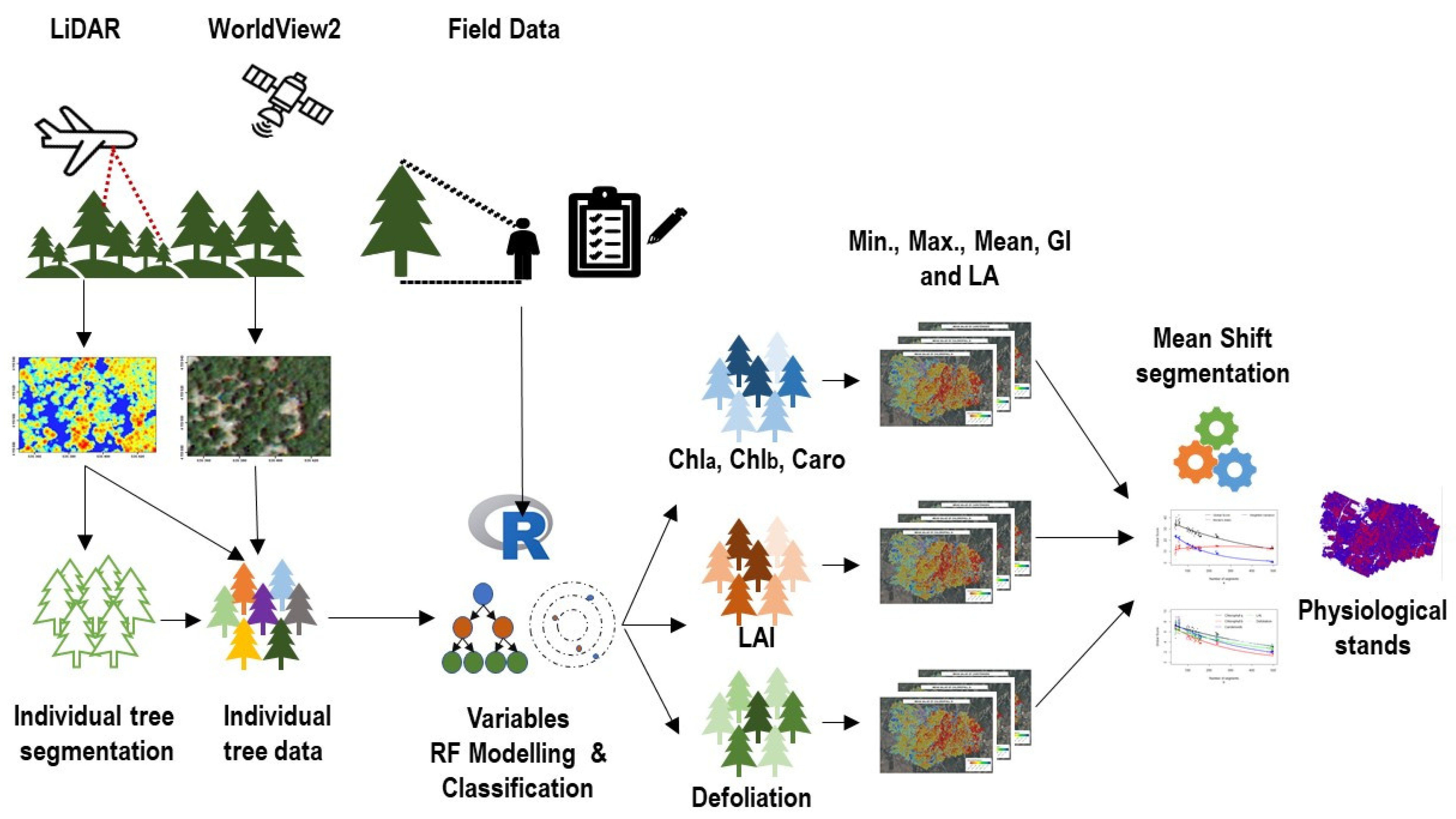
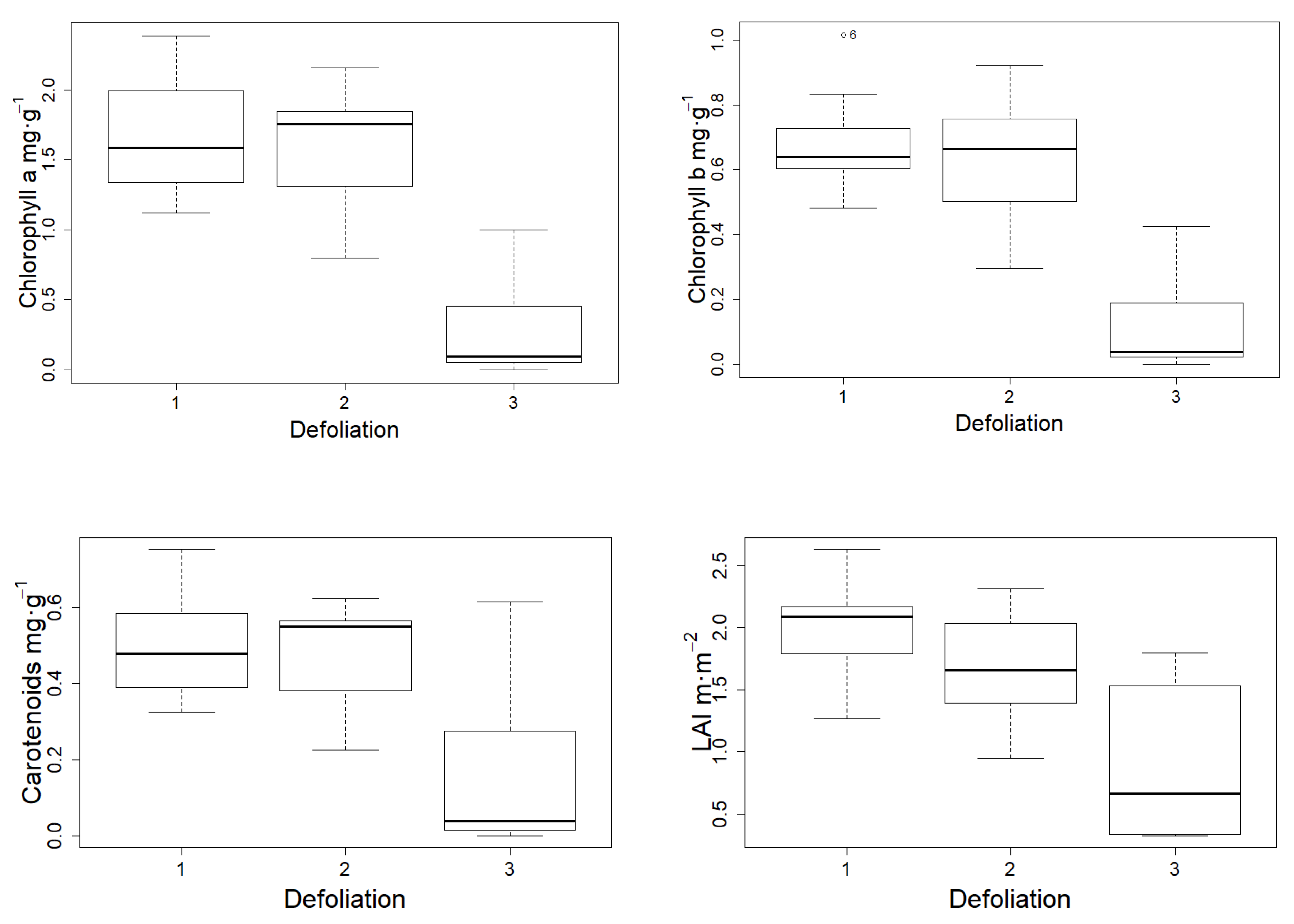
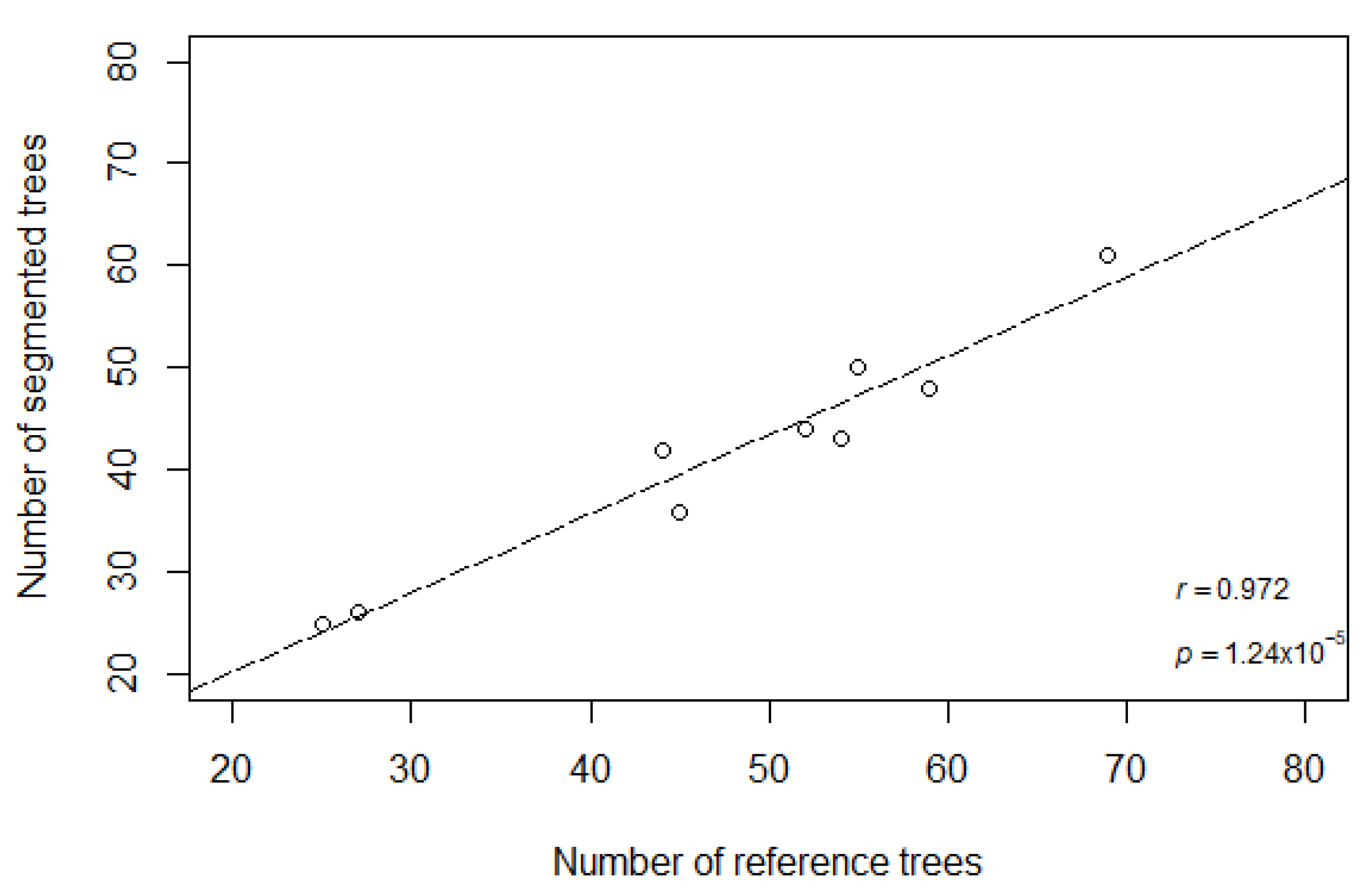
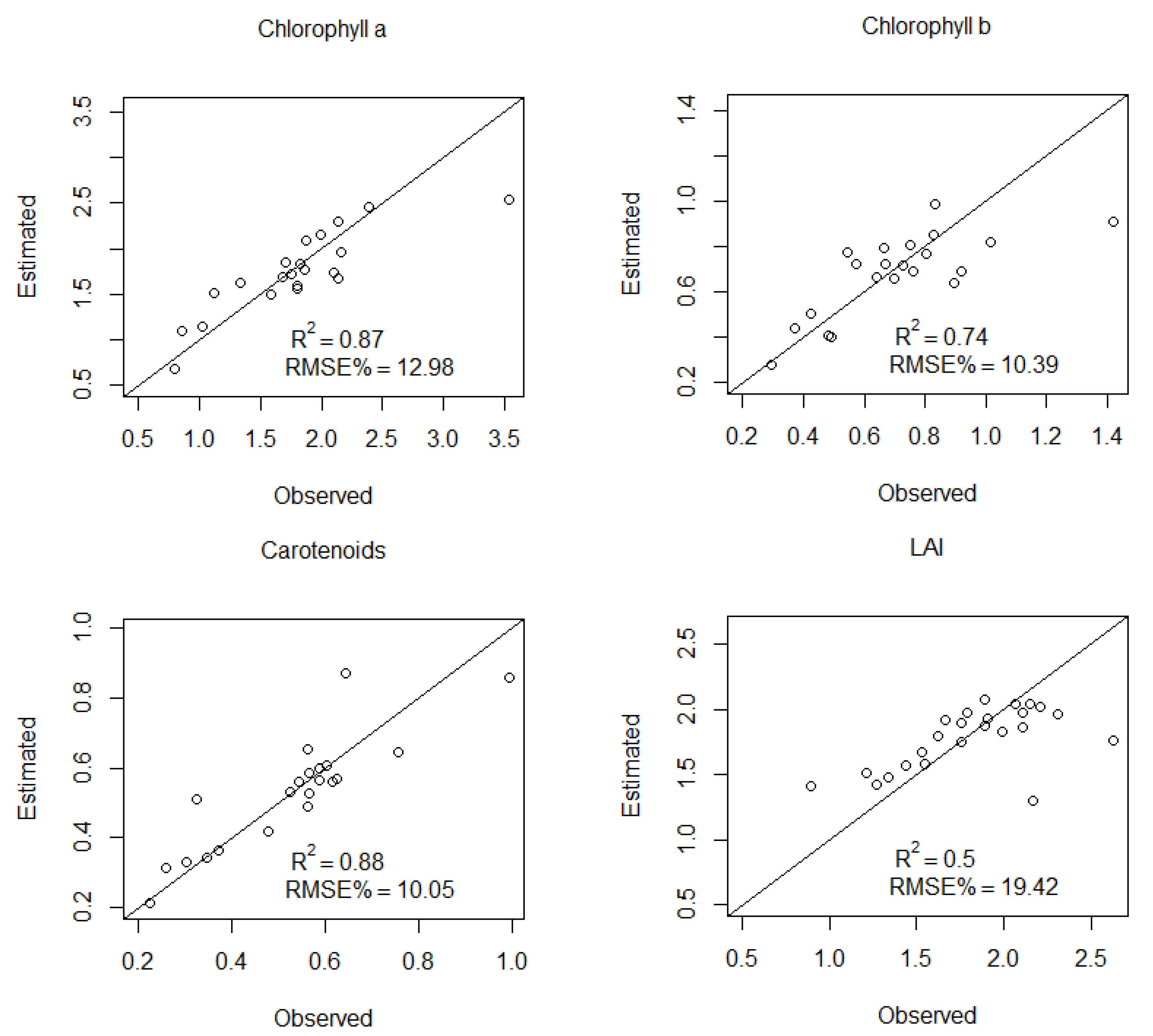
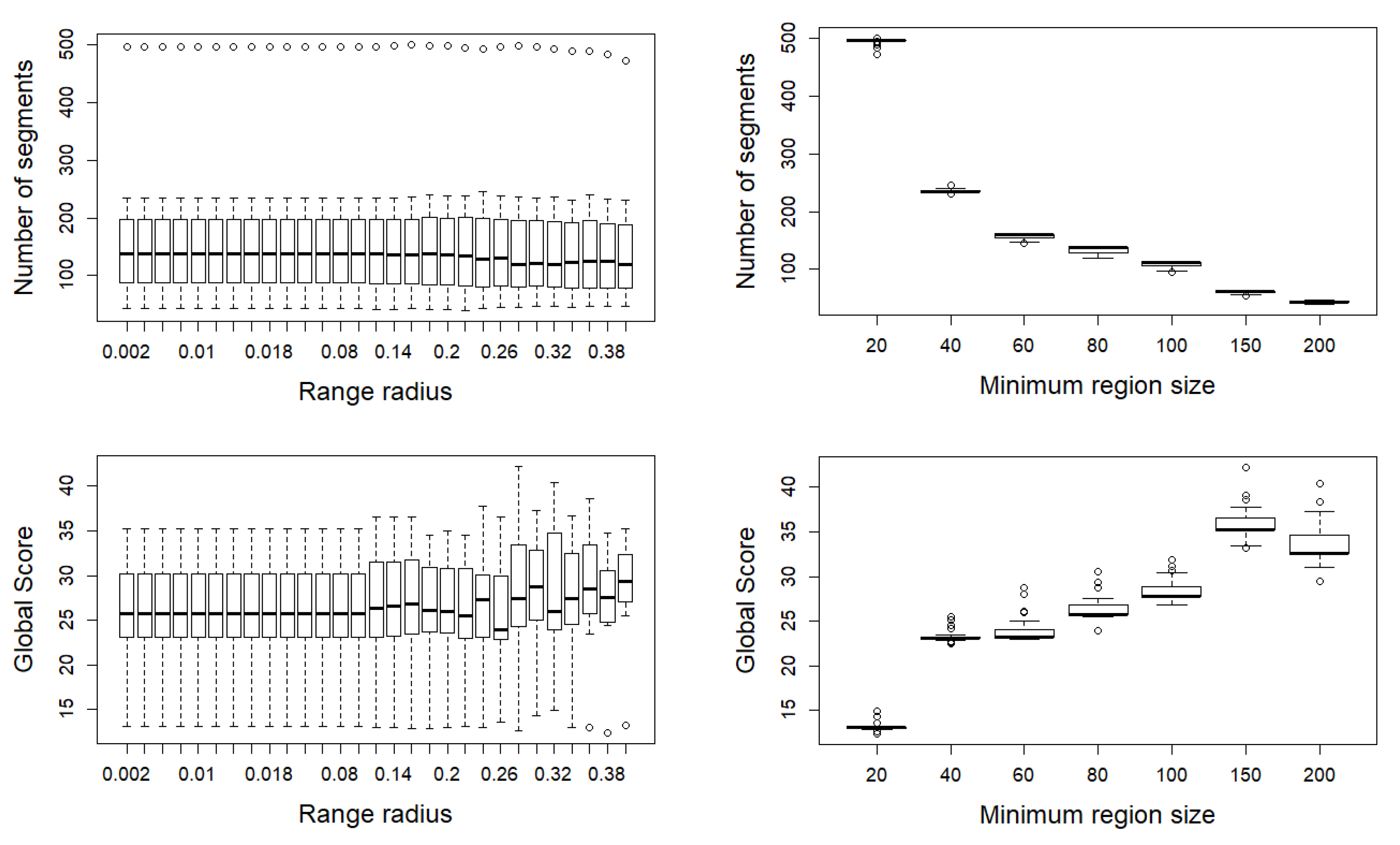
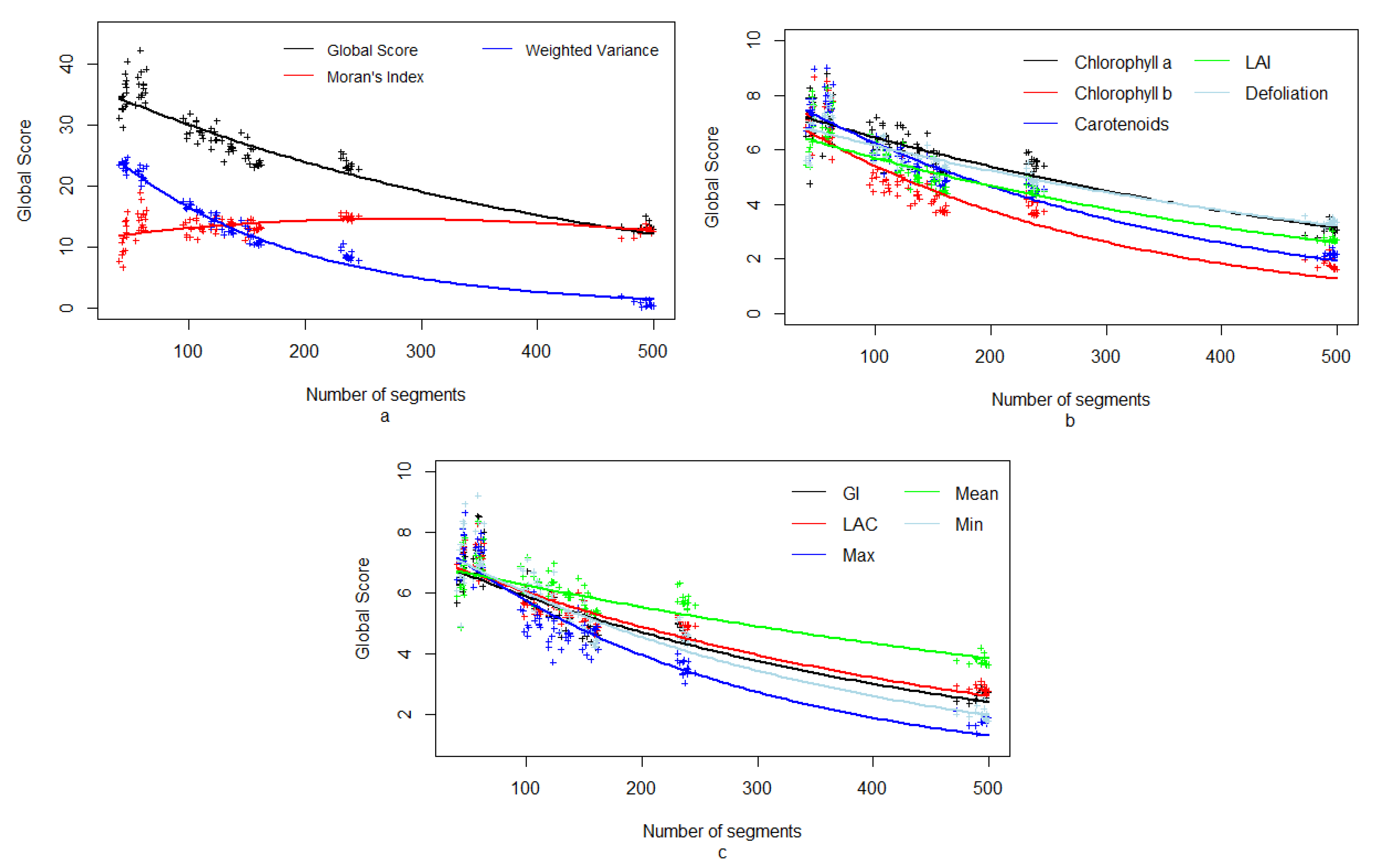
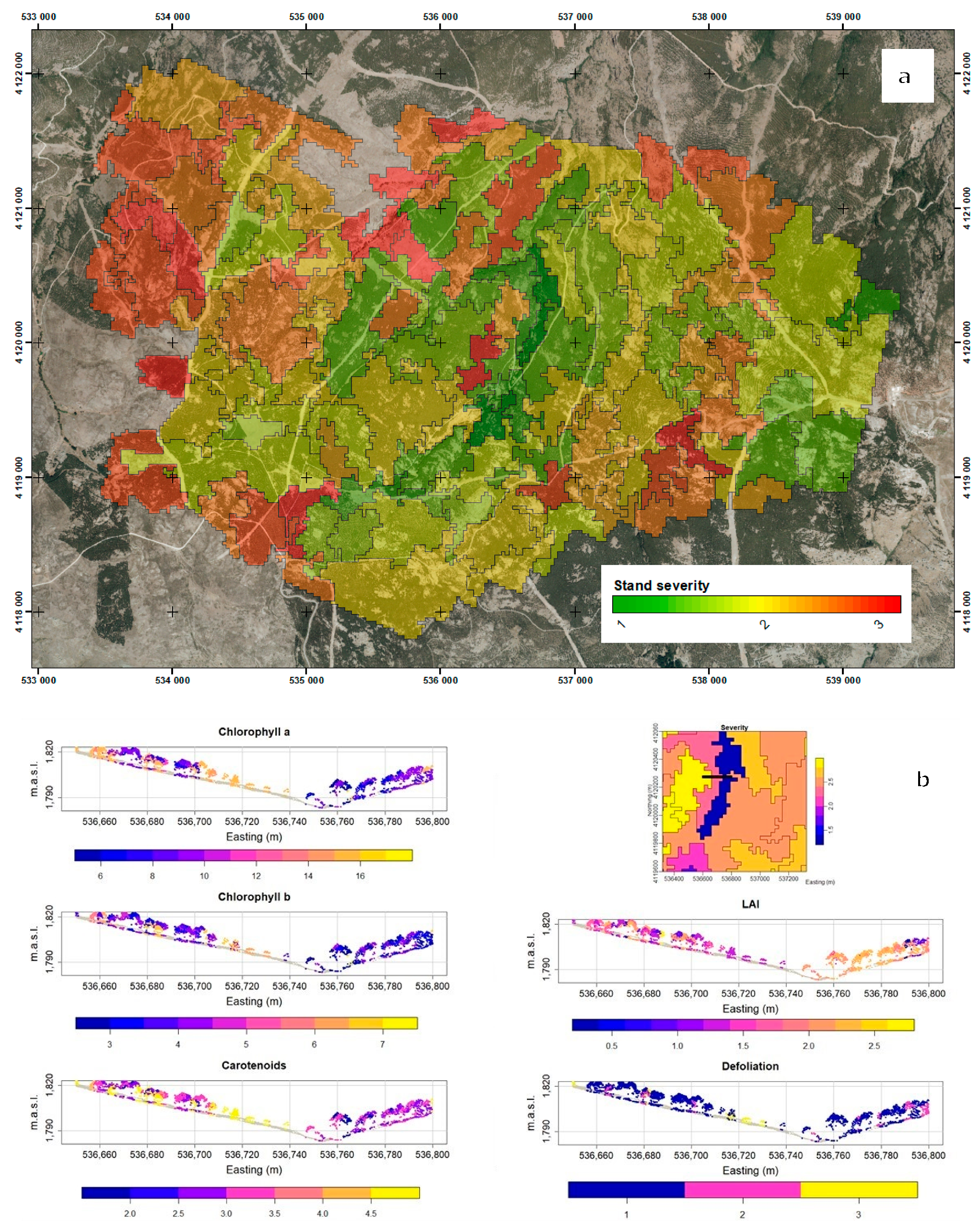
| Measured Variables | No. of obs. | Min | Mean | Max | StDev | Range | Variation Coefficient (%) |
|---|---|---|---|---|---|---|---|
| Pinus sylvestris | |||||||
| H (m) | 430 | 4.34 | 8.62 | 13.02 | 1.68 | 8.68 | 19.42 |
| Dbh (cm) | 430 | 8.70 | 18.50 | 30.1 | 4.03 | 21.4 | 21.79 |
| Ho (m) | 9 | 5.00 | 8.11 | 10.10 | 1.54 | 5.10 | 19.03 |
| BA (m2/ha) | 9 | 18.33 | 26.71 | 40.85 | 7.02 | 22.52 | 26.29 |
| N (trees/ha) | 9 | 509.30 | 952.90 | 1405.66 | 296.58 | 896.36 | 31.12 |
| LAI (m2 m−2) | 45 | 0.30 | 1.84 | 2.82 | 0.64 | 2.52 | 64.54 |
| Chla (mg g−1) | 45 | 0.03 | 1.37 | 2.38 | 0.67 | 2.35 | 49.19 |
| Chlb (mg g−1) | 45 | 0.02 | 0.55 | 1.02 | 0.27 | 1.00 | 49.18 |
| Carc (mg g−1) | 45 | 0.01 | 0.42 | 0.76 | 0.20 | 0.75 | 49.46 |
| Abbreviation | Name | Formula |
|---|---|---|
| Chlorophyll | ||
| CSI | Carter stress index | Band 5/Band 7 |
| NDVI | Normalized Difference Vegetation Index | (Band 7 − Band 5)/(Band 7 + Band 5) |
| GNDVI | Green Normalized Difference Vegetation Index | (Band 7 − Band 3)/(Band 7 + Band 3) |
| PRI | Photochemical reflectance index | (Band 2 − Band 3)/(Band 2 + Band 3) |
| PSRI | Plant Senescence Reflectance Index | (Band 5 − Band 2)/Band 6 |
| RENDVI | Red Edge Normalized Difference Vegetation Index | (Band 7 − Band 6)/(Band 7 + Band 6) |
| Carotenoid | ||
| CRI | Carotenoid reflectance index | (1/Band 3) − (1/Band 6) |
| Leaf Area Index | ||
| NDVI | Normalized Difference Vegetation Index | (Band 7 − Band 5)/(Band 7 + Band 5) |
| REY | Red-Edge Yellow ratio | (Band 6 − Band 3)/(Band 6 + Band 3) |
| Chlorophyll a + b Concentration (mg/g) | |||||
|---|---|---|---|---|---|
| Defoliation | >2.0 | 2.0 < X < 1.0 | 1.0 < X < 0.5 | <0.5 | |
| 0–50% | 1 | 0 | 1 | 2 | 3 |
| 50–75% | 2 | 1 | 2 | 3 | 3 |
| 75–100% | 3 | 2 | 3 | 3 | 3 |
| Plot | Number of Trees | TP | FP | FN | A (%) | OE (%) | CE (%) | r | p | F |
|---|---|---|---|---|---|---|---|---|---|---|
| 1 | 44 | 42 | 1 | 1 | 95.45 | 2.27 | 2.27 | 0.98 | 0.98 | 0.98 |
| 2 | 54 | 43 | 9 | 2 | 79.63 | 3.70 | 16.67 | 0.96 | 0.83 | 0.89 |
| 3 | 59 | 48 | 5 | 6 | 81.36 | 10.17 | 8.47 | 0.89 | 0.91 | 0.90 |
| 4 | 55 | 50 | 5 | 0 | 90.91 | 0.00 | 9.09 | 1.00 | 0.91 | 0.95 |
| 5 | 69 | 61 | 8 | 0 | 88.41 | 0.00 | 11.59 | 1.00 | 0.88 | 0.94 |
| 6 | 52 | 44 | 4 | 4 | 84.62 | 7.69 | 7.69 | 0.92 | 0.92 | 0.92 |
| 7 | 25 | 25 | 0 | 0 | 100.00 | 0.00 | 0.00 | 1.00 | 1.00 | 1.00 |
| 8 | 27 | 26 | 0 | 1 | 96.30 | 3.70 | 0.00 | 0.96 | 1.00 | 0.98 |
| 9 | 45 | 36 | 0 | 9 | 80.00 | 20.00 | 0.00 | 0.80 | 1.00 | 0.89 |
| Overall | 430 | 375 | 32 | 23 | 87.21 | 5.35 | 7.44 | 0.94 | 0.92 | 0.93 |
| Chlorophyll a | Rank | Scale Importance |
|---|---|---|
| PSRI | 1 | 1.584 |
| B4_max | 2 | 1.347 |
| CRI | 3 | 0.436 |
| B8_mean | 4 | −0.517 |
| zmin1r | 5 | −0.527 |
| binc60m | 6 | −0.545 |
| Cov | 7 | −0.709 |
| B5_min | 8 | −1.068 |
| Chlorophyll b | Rank | Scale importance |
| PSRI | 1 | 1.461 |
| B4_max | 2 | 0.579 |
| CRI | 3 | 0.530 |
| binc60m | 4 | 0.032 |
| B8_mean | 5 | −0.165 |
| B5_min | 6 | −0.864 |
| B8_max | 7 | −1.573 |
| Carotenoids | Rank | Scale importance |
| B5_min | 1 | 1.293 |
| B8_mean | 2 | 1.205 |
| PSRI | 3 | 0.574 |
| zmin1r | 4 | 0.459 |
| Cov | 5 | −0.710 |
| CRI | 6 | −0.739 |
| B4_max | 7 | −0.796 |
| binc60m | 8 | −1.285 |
| LAI | Rank | Scale importance |
| B5_min | 1 | 1.482 |
| B3_min | 2 | 0.366 |
| B5_max | 3 | −0.051 |
| CRI | 4 | −0.742 |
| B4_min | 5 | −1.055 |
| Defoliation | Rank | Scale importance |
| binc40 | 1 | 1.281 |
| porclast | 2 | 0.467 |
| B2_max | 3 | 0.248 |
| GNDVI | 4 | −0.787 |
| B2_mean | 5 | −1.209 |
| Reference | ||||||||||
|---|---|---|---|---|---|---|---|---|---|---|
| Prediction | Cross-Validated Data | User’s Accuracy | Evaluation Data | User’s Accuracy | ||||||
| SLD | MLD | SVD | Σ | SLD | MLD | SVD | Σ | |||
| SLD | 129 | 16 | 10 | 155 | 83.23 | 51 | 9 | 5 | 65 | 78.46 |
| MLD | 14 | 84 | 0 | 98 | 85.71 | 5 | 38 | 6 | 49 | 77.55 |
| SVD | 7 | 0 | 40 | 47 | 85.11 | 0 | 0 | 16 | 16 | 100 |
| Σ | 150 | 100 | 50 | 56 | 47 | 27 | ||||
| Prod.’s Accuracy | 86 | 84 | 80 | 91.07 | 80.85 | 59.26 | ||||
| Overall Accuracy | 84.05 | 80.77 | ||||||||
| Kappa | 0.76 | 0.69 | ||||||||
Publisher’s Note: MDPI stays neutral with regard to jurisdictional claims in published maps and institutional affiliations. |
© 2021 by the authors. Licensee MDPI, Basel, Switzerland. This article is an open access article distributed under the terms and conditions of the Creative Commons Attribution (CC BY) license (http://creativecommons.org/licenses/by/4.0/).
Share and Cite
Varo-Martínez, M.Á.; Navarro-Cerrillo, R.M. Stand Delineation of Pinus sylvestris L. Plantations Suffering Decline Processes Based on Biophysical Tree Crown Variables: A Necessary Tool for Adaptive Silviculture. Remote Sens. 2021, 13, 436. https://doi.org/10.3390/rs13030436
Varo-Martínez MÁ, Navarro-Cerrillo RM. Stand Delineation of Pinus sylvestris L. Plantations Suffering Decline Processes Based on Biophysical Tree Crown Variables: A Necessary Tool for Adaptive Silviculture. Remote Sensing. 2021; 13(3):436. https://doi.org/10.3390/rs13030436
Chicago/Turabian StyleVaro-Martínez, Mª Ángeles, and Rafael M. Navarro-Cerrillo. 2021. "Stand Delineation of Pinus sylvestris L. Plantations Suffering Decline Processes Based on Biophysical Tree Crown Variables: A Necessary Tool for Adaptive Silviculture" Remote Sensing 13, no. 3: 436. https://doi.org/10.3390/rs13030436
APA StyleVaro-Martínez, M. Á., & Navarro-Cerrillo, R. M. (2021). Stand Delineation of Pinus sylvestris L. Plantations Suffering Decline Processes Based on Biophysical Tree Crown Variables: A Necessary Tool for Adaptive Silviculture. Remote Sensing, 13(3), 436. https://doi.org/10.3390/rs13030436








